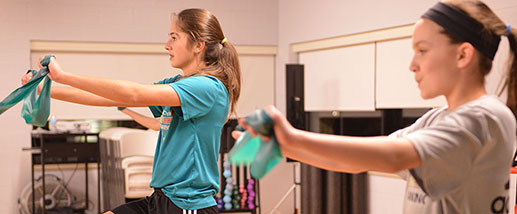Shoulder Arthritis is a Pain — But Very Treatable
November 16, 2023
By: Darin Estep
Categories: Men's Health, Orthopedics (Bones, Joints, Muscles), Women's Health
Tags: shoulder pain
The pain started in her upper arm. It felt like a sore bicep muscle. And at first, Diane Benson thought she might have injured it somehow or maybe slept wrong.
When it didn’t get better on its own, she decided to see someone about it.
As a communications manager for Trinity Health in West Michigan, she knew just who to see - Tim Lenters, MD, an expert in treating shoulder conditions and a pioneer in shoulder surgery.
“Dr. Lenters took some X-rays and came back and said, ‘You've got a significant amount of arthritis, particularly in your left shoulder. There’s next to no cartilage there.’” Benson said.
“I was shocked and thought, ‘I'm not old enough to have arthritis!’”
Benson was correct that shoulder arthritis becomes more prevalent with aging. But even though most of his patients are 60 and older, Dr. Lenters said younger patients can show early stages of damage to the cartilage in the shoulder joint.
In fact, shoulder arthritis is quite common, affecting millions worldwide and an estimated 1 in 3 people over age 60. That can cause some problems, given the many things we expect our shoulder to do in its role as the body’s most flexible joint.
“Typically, patients with shoulder arthritis will complain of a lot of nighttime pain,” he said. “They will describe mechanical symptoms, such as clicking and popping in the shoulder. Quite frequently they'll have a loss of mobility, so the joint will stiffen up,” Dr. Lenters said.
“And then I guess the most significant issue with them is that they have an activity-related pain that prevents them from performing the activities that they typically enjoy doing.”
Treatments for arthritis pain
The bad news: Once arthritis starts there’s really no way to stop it.
The good news: Symptoms can be managed for some time with medications, injections and physical therapy to maintain range of motion.
And when surgery does become necessary, great options are available with a very high success and satisfaction rate for patients. Many are back on the golf course or pickleball court in a few months.
“If you look across the entire spectrum of the medical community in all specialty areas, total shoulder replacement is probably one of the top three things you can offer patients to improve their quality of life,” Dr. Lenters said. “It's a ridiculously successful surgery for the vast majority of patients.”
Still, he said, patients don’t need to rush into the surgery. And in Benson’s case, physical therapy and stretching is working to restore her range of motion and reduce the pain. She was surprised to learn how much the pain was affecting her everyday activities.
“You don't even realize how much you compensate for the pain by reducing how much you actually move your arms,” she said, noting she is going to stick with the physical therapy. “You can’t grow back the cartilage that is missing — but you can work to put off surgery until it can't be avoided.”
That’s how Dr. Lenters describes his advice to patients.
“There's really no risk of waiting. The primary indication for doing surgery is that you're just tired of the pain,” he said. “Everybody has a different threshold, but if night after night you're not getting in good rest, it affects everything about you — your mood, your ability to concentrate, your interaction with your family. So that's often one of the symptoms that drives people to seek help.”
Shoulder surgery options
Shoulder replacement is a relatively new procedure, emerging in the 1970s and undergoing multiple improvements since, Dr. Lenters said.
“More recently, I’ve taken a liking to the planning of procedures with a preoperative CT scan,” he said. “This allows us to plan and perform the surgery virtually ahead of time. The accuracy is remarkable. We can precisely execute that surgical plan using tools we just didn’t have 10 years ago.”
There are two main types of surgical replacement of the ball-and-socket joint of the shoulder, he said.
Anatomic shoulder replacement: This involves replacing the existing ball at the top of the upper arm bone and attaching a plastic socket over the top of the existing shoulder.
Reverse ball and socket replacement: Dr. Lenters was the first surgeon in West Michigan to perform this type of surgery, and it is the method he now uses for between 70% and 80% of his shoulder replacements. As the name implies, this surgery replaces the existing socket with a ball, and a socket is placed where the ball used to be.
The original application of this surgery was for patients missing rotator cuff, the group of four muscles that come together as tendons to keep the shoulder in place, Dr. Lenters said.
“Initially, this was done to restore stability to a shoulder that was instable due to loss of the rotator cuff,” he said. “But we've also learned that if patients do have significant loss of bone, that the reverse functions better and has better longevity than the anatomic or the regular shoulder replacement.”
Shoulder replacement surgery usually takes about an hour with the patient under general anesthetic, Dr. Lenters said. A nerve block numbs the arm, which improves pain control. Close to 90% of patients go home the same day.
After limiting arm activity for about six weeks, patients perform home-based physical therapy. Most resume normal activities after three or four months, with continued progress in range of motion and strength for a year.
“I tell patients that they'll drop five to 10 strokes on their golf game if they replace their arthritic shoulder joint. That's pretty typical,” Dr. Lenters said. “People can go play tennis. People can play pickleball with these shoulder replacements. People kite surf and windsurf with them.”
Watch this 60-second video for six tips to avoid shoulder pain by Dr. Lenters. To request an appointment with an orthopedic expert, visit www.trinityhealthmi.org/ortho.




